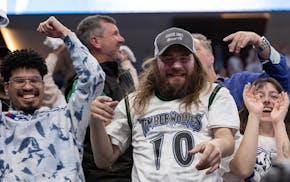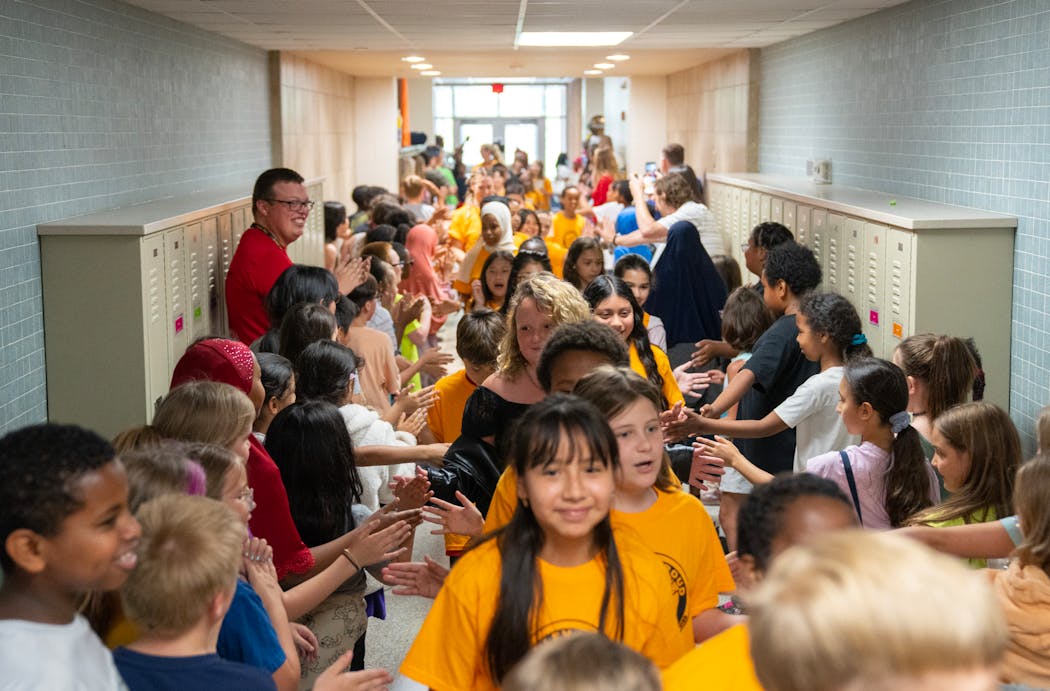Gaeli Iverson, principal of Hayes Elementary in Fridley, thinks a lot about the children who aren't attending her school — at least not yet.
She visits nearby day cares and preschools, drumming up enthusiasm among families who face many options of where to send their child to kindergarten. And she's quick to snap photos and videos of fun school traditions to share on the district's social media.
"It used to be you just went to your neighborhood school and you didn't have choices of where else to go, but that hasn't been true for a long time," said Josh Collins, director of communications for Fridley public schools.
Traditional public school enrollment across Minnesota has slipped for three consecutive years as families select other options: Charter schools and private schools saw bumps in enrollment and the number of homeschooled students across the state surged during the pandemic. As the new school year begins Tuesday, school district leaders hope to reverse that trend.
That means they are thinking about how — and to whom — they should intentionally market their schools. State funding is doled out per pupil, so attracting and keeping students is crucial to a district's bottom line. When each student means about $10,000 for a school, losing even a handful of families can be costly.
Terms like "customers," "marketing" or "branding" were long seen as dirty words in education and district communication, said Julie Schultz Brown, the Minneapolis Public Schools' recently retired director of marketing and communications. But that has shifted in recent years, accelerated by the push to boost enrollment and influenced by the ubiquity of social media.
"If we want to preserve a 150-year-old institution like Minneapolis [Public Schools] and of course we do ... then we have to think about what our audiences want," Schultz Brown said.
A fix for falling enrollment?
MPS, which served about 35,000 students in 2016, is down to about 28,000. Amid projections of a continued slide, district staff in Minneapolis schools have redoubled efforts to promote the city's schools.
District staff have been attending community events and parades and have prioritized targeted marketing efforts. That includes mailed information, billboards and video messages that play at gas station pumps across the city.
"We're trying to get to families when their baby is born so that at least once a year something goes to them so they know that MPS is one of their options," Schultz Brown said.
The district is also rolling out a new website by the end of the year.
St. Paul Schools, which saw its enrollment slip by about 1,000 students between fall 2021 and fall 2022, published a kind of catalog to help parents understand the many options for the district's 33,000 students. Those choices include language immersion and magnet schools as well as International Baccalaureate and Montessori programs.
With so many options, both within and outside the public school district, families can be overwhelmed while trying to look for something specific, said Erica Wacker, the director of communications for St. Paul Public Schools.
This year, St. Paul is launching marketing efforts to help boost enrollment at six schools: Hamline Elementary, Highwood Hills Elementary, Riverview Spanish/English Dual Immersion Elementary, Cherokee Heights Elementary, Dayton's Bluff Elementary and Txuj Ci Hmong Language and Culture Upper Campus. Each of those schools will get $50,000 to help with marketing. The new East African Magnet School will have a similar marketing budget, Wacker said.
The district also uses billboards, digital and social media ads and recently partnered with Sheletta Brundidge, a local radio host and podcaster, to promote the district's School Choice Fair.
Still, a survey of St. Paul parents showed that the majority of parents used "friends and family referrals" to research and choose a school.
"Word of mouth is still king," Wacker said. And marketing efforts "should never take the place of and aren't effective without a high-quality product behind it."
Selling success and community
In Minnetonka public schools, enrollment has remained stable in recent years, buoyed by the district's aggressive open-enrollment strategy to draw students from outside the attendance boundaries. About 40% of the district's students are open-enrolled.
The district leverages "authentic content" as the "biggest vehicle for getting the word out about our schools," said JacQui Getty, executive director of communications for Minnetonka schools. That means sharing stories and videos of student successes and communicating often with families, she said.
The high school principal's Instagram account has more than 5,700 followers in a district that serves about 11,000 students. And last spring, the superintendent began hosting a podcast as a new way to communicate with families.
Though parents in metro areas may have more school choices than those in rural areas, leaders in small districts are also thinking about what message to send the community.
Kerry Juntunen, the superintendent of Proctor public schools in northern Minnesota, has two daughters who work in marketing. Dinner table conversations, Juntunen said, often veer toward some version of, "Dad, what's the story of Proctor public schools?
His answer: small class sizes across the district of about 1,800 students, the career and technical education offerings through the high school's pathways program and a commitment to school-community partnership.
"One of the things I noticed about kids and the parents here is that they are very service-minded. They have a strong sense of community and what they need to do for each other," Juntunen said. "We can market that."
Though the district is too small to have a dedicated communications team, Proctor schools' staff get help from #SocialSchool4EDU, a Minnesota-based company that helps more than a dozen school districts in the state train employees to be "social media storytellers to stand out from other schools, celebrate your students and staff, and reach thousands in your community every day," according to the website.
Scenes from school
For school leaders in Fridley, the return of in-person traditions after pandemic-era distance learning was a chance to rethink marketing efforts.
Fridley schools enrolled about 2,500 students last school year, down from about 2,900 in 2017-2018. About 25% of students living within the district chose to enroll outside it last year.
But attracting students from other places has stemmed the tide somewhat: Over 40% of students attending Fridley schools last year open-enrolled from elsewhere.
"I think one of the ways that we really market our school is by sharing the stories of the beauty within it," Iverson, the Hayes principal, said.
The key, said Collins, the communications director, is showing parents something authentic, not just overly polished productions.
That might be a photo or a quick video from school.
"Who's a better storyteller than a child experiencing joy?" he said.

Why did the Minneapolis Lakers basketball team move to Los Angeles?



